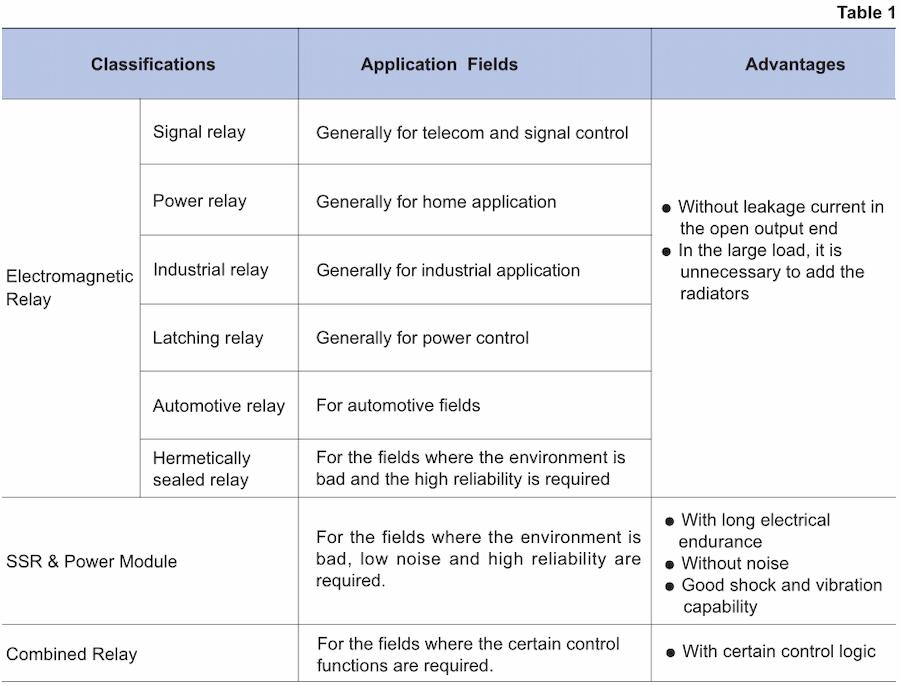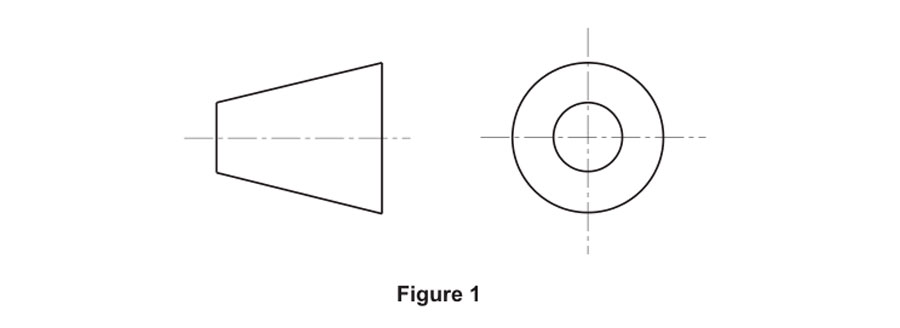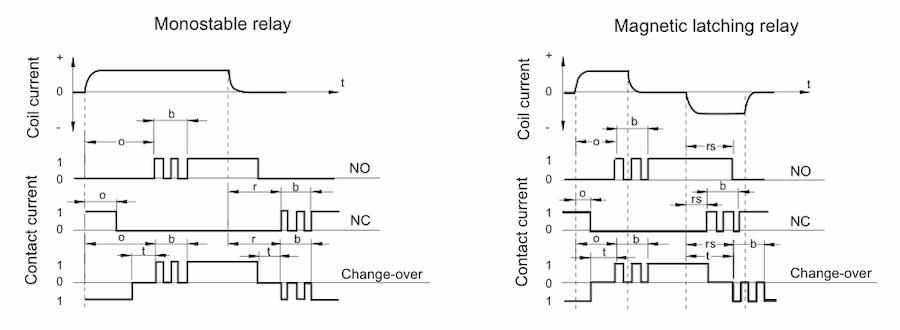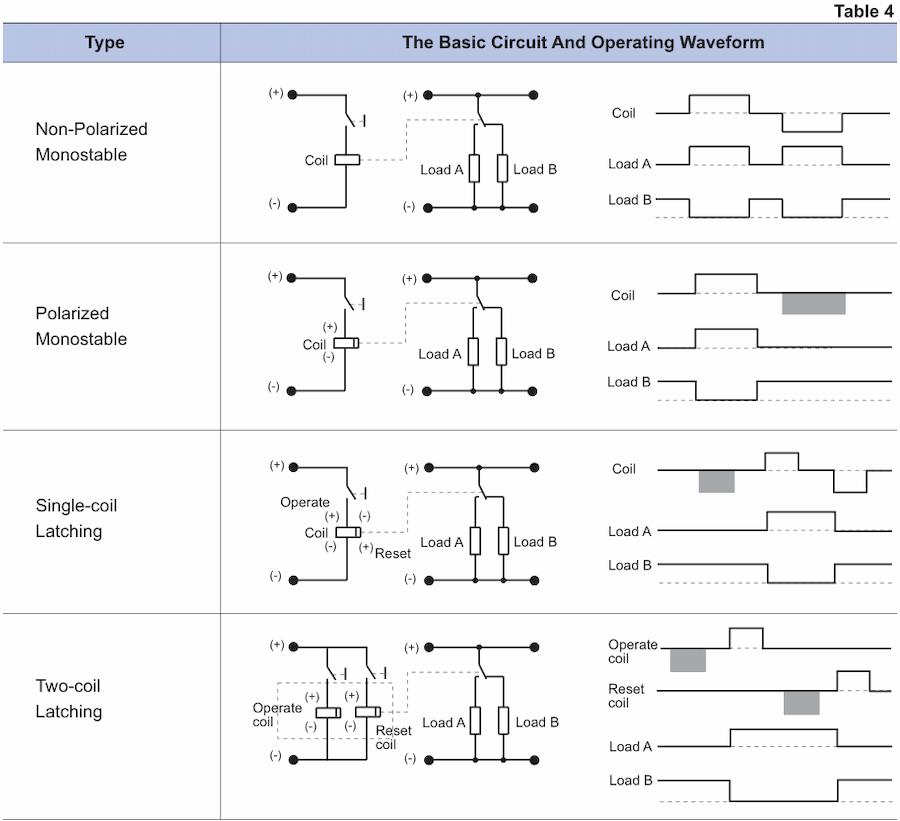HF and its affliates have made every effort to guarantee the accuracy of instructions and specifications. Still, errors may occur. Therefore, HF and its affiliates reserve the right to make any modification to the instructions and specifications.
HF and its affiliates claim only the responsibility of the clearly confirmed experiment clauses and condition of sale as well as the application condition and test results stated in particular specifications. We disclaim any assumptions or implications of any of our specifications and instructions.
Given the impossibility of defining all the requirements of all the relays in every application, users shall select relays accordingly and re-check through careful evaluation, or turn to HF and its affiliates for technic support if necessary. Users shall take full responsibility for relay selection.
Relay is a kind of component by which when the input is reached to a certain value, one or more outputs will produce the scheduled changes.
For electromagnetic relay, SSR and combined relay, it can be simply understood as the following way: it is a switch by which in the input end the speculated electrical signals are applied, the output end makes or breaks the controlled circuit.
There are many kinds of classifications about relay, we take the following classifications shown as table 1.

According to the classifications of relay, our catalogue can be divided into general relay fascicule, automotive relay & module fascicule, industrial relay fascicule, latching relay fascicule and hermetically sealed relay fascicule.
In general relay fascicule, power relay and signal relay are included; and in automotive relay & module fascicule, plug-in relay, PCB relay and automotive module are included. We also provide the sockets which match to the relays.
This article states the basic information about the electromagnetic relay, lists the selecting principles and cautions of applications.
Generally the parameters of the instructions in the catalogue are the measured initial values under the standard, which are as following, unless otherwise stated.
1) temperature: 15℃ to 35℃
2) relative humidity: 25% to 75%
3) air pressure: 86kPa to 106kPa
Generally the drawing stated in the catalogue is the first quadrant projection way as shown in figure 1, unless otherwise stated.

1.1 Contact forms are the arrangements of relay contacts. The basic contact arrangements are shown in Table 2, the multi-contact arrangements can be ratiocinated.

1.2 Contact resistance is the total resistance between the contacts, the terminals and spring jointed with contacts, generally shown in mΩ.
Unless otherwise stated in the catalogue, generally for the relay with contact load below 2A, its contact resistance is measured in 6Vd.c.,0.1A; for the relay with contact load above 2A, its contact resistance is measured in
6Vd.c.,1A. contact resistance should be tested with the max applicable voltage and current according to the corresponding load type in IEC61810-7.
1.3 Contact voltage drop generally is, in the load circuit, the total voltage drop between contacts, springs jointed with contact and the terminals. It is generally described as the voltage drop value under the regulated current, for example 50mV(measured in 10A).
1.4 Contact material is the material used in contacts and generally shown in chemistry formula, for example, AgNi represents silver-nickel alloy contacts. The material used in the relay, its characteristics and its application environment can be seen in 1.2' Contact material' in chapter 2' the principles for selecting relays'.
1.5 Contact rated load generally refers to the load of which the contacts can switch reliably under the certain regulated conditions. Generally it is shown as the combination of the voltage and the current. The loads listed in the catalogue are resistive loads, unless otherwise stated.
1.6 Max. switching voltage is the maximum load voltage of which the contacts can switch. In general application, this voltage value shall not be surpassed, or the relay endurance will be reduced.
1.7 Max. switching current is the maximum load current of which relay contacts can switch. In general application, this voltage value shall not be surpassed, or the relay endurance will be reduced.
1.8 Max. switching power is the maximum load power of which relay contacts can switch reliably. Generally for AC it is shown in VA while for DC it is shown in W.
1.9 Mechanical endurance refers to the operations that the relays without load or with load do not lead to failure under the rated voltage, normally switch in the specified, generally it is shown in operations.
1.10 Electrical endurance generally refers to the operations that the relay can normally switch when the specified load is applied on the contacts and the rated voltage is applied to the coil under the conditions that the relay is placed in the certain speculated environment. Generally it is shown in operations.
1.11 Surge current generally refers to the maximum transient current of which relay can endure in the specified load.
1.12 Min. applicable load generally is reference value of minimum load that the relay can switch. Please perform the confirmation test with actual load before production since reference value may change according to switching frequency, environmental condition and expected contact resistance and reliability.
2.1 Insulation resistance is the impedence when the conductors insulated with insulating material are applied to voltage and it is generally shown in "MQ". The speculated voltage discribed above are general 500Vd.c.(or 250 Vd.c.).
2.2 Dielectric strength is the voltage value when, within the speculated time, the conductors insulated with insulated material are applied to the voltage and the leakage current is less than the speculated current. The certain voltage above generally is the effective value of AC voltage and unless otherwise stated, the leakage current is generally less 1mA.
2.3 Operation time refers to, with the relay in the released state, the elapsed time from the initial application of power to the coil, till the closure of the normal open contacts. It does not include any bounce time, and expressed in "ms".
For the latching relays, operation time refers to, with the relay in the reset state, the elapsed time from the initial application of power to the coil, till the closure of the normal open contacts. Seen in figure 2.
2.4 Release time refers to, with the relay in the operation state, the elapsed time from the initial removal of coil power till the re-close of the normal closed contacts. It does not include bounce time and expressed in "ms".
Seen in figure 2.
2.5 Reset time(only for the latching relays) refers to, with the relay in the operation state, the time from the first application of power to the reset coil till the re-close of the normally closed contacts. Seen in figure 2.
2.6 Bounce time generally refers to the time from the initial close of the contacts till the complete close and generally expressed in "ms". Seen in figure 2.

o: operation time r: release time t: switching time b: bounce timers: reset time 0: the contacts open 1: the contacts closed
Figure2
2.7 Switching frequency refers to the cycling times of the operation and release in united time.
2.8 Ambient temperature refers to the temperature in which the relay can normally be applied and it is generally expressed in the range of temperature.
2.9 Coil temperature rise refers to the temperature that the coil rises by after the temperature becomes stable and under the conditions that in the suitable maximum ambient environment the rated voltage is impressed on the coil and the rated load is impressed on the contacts. Generally it refers to the maximum value, expressed
2.10 Shock is divided into shock functional and survival.
Shock functional refers to the acceleration the relay can suffer the shock value under the condition of the NC contact open time and open contact closing time at specified time. Usually it is expressed in the combination of the acceleration value "g" and the duration "ms".
Shock survival refers to the shock value that can not damage the relay construction, Usually, it is expressed in the combination of the acceleration value "g"(1g=9.8m/s?) and the duration "ms".
2.11 Vibration resistance is divided into Vibration function and survival.
Vibration function refers to the vibration the relay can suffer without causing the closed contacts to open for more than the specified time and the open contacts to close for more than the specified time. It is usually expressed in the combination of the vibration "mm"and the vibration frequency "Hz".
Vibration survival refers to the vibration the relay can suffer without damaging their construction. It is usually expressed in the combination of the vibration "mm" and the vibration frequency "Hz".
2.12 Humidity refers to the required humidity in which the relay can reliably work and generally expressed in relative humidity "% RH".
2.13 Model Of The Terminals model of the relays also shows the applicable fields. Generally speaking, the models of terminals are PCB, THT, SMT, plug-in, QC and others.
2.14 Weight: the weight of the relay.
2.15 Enclosure type refers to the protection mode for the relay body. It is divided into enclosed, dust protected, flux proofed, plastic sealed and hermetically sealed. Seen in 3.1' mode of encapsulation' in chapter 2' the principles of selecting the relays'.
3.1 The rated coil power refers to the power consumed by the coil when the coil are applied to the rated voltage. Generally, for the DC relay, it is expressed in W while for the AC relay in VA.
3.2 Rated voltage is the voltage applied to the coil that can make relay work normally. It is expressed in "V". For the polarized relay, the direction in which the voltage is impressed should be notified.
3.3 Operate voltage is the voltage which closes the NO contacts when the relay is in the releasing state (for the latching relay in the reset state) and the coil voltage is increased gradually. Usually it is expressed in "V". It is usually the maximum value listed in the instructions, which is about 80% of rated voltage.
3.4 Release voltage is the voltage which closes the NC contacts when the relay is in the operation state and the coil voltage is gradually reduced from the rated voltage. It is usually expressed in "V". The minimum value is listed in the instructions, which is about 10% of the rated voltage.
3.5 Reset voltage is the voltage which closes the NC contacts when the latching relay is in the operation state and the reset coil voltage is increased. It is expressed in "V". The maximum value is listed in the catalogue, which is about 80% of the rated voltage.
3.6 Coil resistance generally refers to the DC resistance and is expressed in "Q". In the catalogue the combination of the nominal value and tolerance is given.
3.7 Maximum voltage refers to the maximum voltage which relay coil could endure in a short period of time. It is expressed in V.
4.1 UL Approval
UL, the abbreviation of Underwriter Laboratories Inc, is a non-profitable organization founded in 1984. The electrical products authorized by this organization can be freely sold in American market, while the electrical products not authorized by this organization will be limited when they are sold in most of the states of America.
Due to the authority of UL, the products approved by UL are accepted by many countries.
4.2 CSA Approval
CSA, the abbreviation of Canadian Standards Association, is the authorized approval institution. The electrical products approved by this institution can be freely sold in Canadian market. The products approved by the CSAcan be only sold in Canadian market and if these products want to enter into the American market, they should get the American approval of UL.
4.3 UL& CUR
UL& CUR is the approval which simultaneously meets the American standard and the Canadian standard and can be used in North America.
4.4 VDE Approval
VDE, the abbreviation of Verband Deutscher Elektrotechniker, is one of Germany authorized organizations in electrical component and other equipment. The electric products approved by this institution will be admitted in Germany law.
4.5 TUV Approval
TUV, the abbreviation of Technischer iberwachungsverein, has the same authority as VDE. TUV is one of the authorized institution in electric equipments. The electric products approved by this institution will be admitted in Germany law.
4.6 CQC Approval
CQC, the abbreviation of China Quality Certification, is the most authorized approval institution in China. The products not listed in the catalogue of 3C approval can make CQC approval in China Quality Certification Center.
Ordering code is a code which is used to ensure the type and the specifications of the relay, which includes the basic information of relay, such as the type of the products, coil voltage, contacts arrangement, enclosure type, etc. The ordering code of HONGFA brand relay can be seen in Chapter 5 "the ordering code".
Ordering mark is a mark which is used to ensure the type and the specifications of the relay, which includes basic information of the relays, such as the type of the products, the coil voltage, contacts arrangement, the mode of encapsulation, etc. The ordering marks of HONGFA brand relay can be seen in Chapter 5 "the ordering marks".
6.1 Outline dimensions describe the drawing of the relay outline size and the mounting space needed by relay.
6.2 Wiring diagram describes the wiring way of the input and output terminals respondent to the terminals of the relays.
6.3 The size drawing of the mounting holes describes the position of the relay terminals and the size of their mounting holes.
6.4 Examples
The examples of the common components can be seen in table 3.

7.1 Max. switching power curves represent the loads the relay can support.
7.2 Electrical Endurance Curve: The electrical endurance curve indicates the typical endurance under rated load.
The data of all the electrical endurance do not guarantee a minimum value.
1) The data of all the electrical endurance are only valid for stated contact materials, special contact materials excluded. No deductions should be made from the data.
2) No deductions should be made from the data, especially to the situation when the current is below 0.5A as contact wear is not the dominant failure mode.
7.3 Coil temperature rise curve shows the measured temperature rise value of the coil when the relay is energized with different voltage and loads under the speculated ambient temperature.
8.1 Monostable Relay:
For this relay, the contacts operate when the coil is energized while the contacts will reset when the coil is deenergized.
8.2 Latching Relay:
For this relay, the contacts operate when the coil is energized while the contacts will keep the state when the coil is deenergized. To reset the contacts, the counter-energization will be applied to the single-coil coil or the energization is applied to the double-coil reset coil.
8.3 Polarized Relay:
The switch of the contact state is dependent on the polarity of the energized voltage in the terminals of the coil. Part of the monostable relays and all the magnetic latching relays belong to polarized relays.
The basic circuit and operating wave of the several common relays can be seen in table 4.

Notes: the voltage with the correct polarity is required to impress on the coil of polarized relays or the relays will not work, as shown in the shaded area in the figures above.